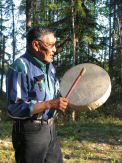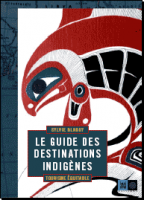Text and photos : Pam Wight

The Birch Narrows Dene Nation lived in the region of this lodge for centuries, in various temporary settlements and camps which corresponded to their hunting grounds. After signing Treaty with the government 100 years ago, they have clustered in most established settlements. Today, the Birch Narrows Dene Nation still live very close to the land, and nearly all band members have Dene as their first language. Hunting, trapping, fishing and hide tanning continue to be part of their routine activities. In 2000, led by Chief Robert Sylvestre, the community used local timber to hand-build a lodge, cabins, ice house, furniture, and even boats. His vision was that a lodge could be a place where Band members and visitors could practice traditional skills, a location for special functions for youth and seniors, where cultural renewal could take place, and where there would be an opportunity for economic benefits to the community.
Since all lodge staff and guides are Dene who are familiar with the region and living on the land, the guest experience is authentically aboriginal, evidenced in the food, boating, hiking and wildlife viewing. The lodge objectives are to interpret and preserve the unique local and regional environment. Guests can take forest walks or wilderness interpretive hikes, learn survival skills, follow animal trails, go boating or canoeing, portage between lakes, view wildlife, learn about the land, track animals, climb hills, visit islands, view ancient rock paintings, learn about the land and the relationship of the Dene to that area, fish for shore meals, and watching elders prepare foods in the traditional way. _ Guests are provided with experiences full of learning, appreciation of the natural environment and the culture of the First Nations hosts. The forests south of the Canadian Shield are not as dense as further south, so hiking is easier. The area abounds with wild flowers and plants, and wildlife includes moose, woodland caribou, deer, beaver, black bear, wolves, coyotes, mink, wolverine, muskrats, weasel, fisher. Birds include bald eagles, hawks, grouse, waterfowl, and the great white pelican.
The First Nation are completely involved in all aspects of programming, resulting in opportunities for cultural pursuits, such as moose hide preparation, bead work, leather sewing, drum dances, singing, and preparation of traditional medicines, teas, and food. Guests may assist the Dene to set nets in the lake, smoke fish traditionally, collect Labrador tea to contribute to the communal food, or try to chew a plug of spruce gum. Each group of guests is invited to a remote festive meal, where all camp elders, staff, attendants and guides share too – participating in catching, preparing, cooking, and eating the meal.
The lodge, located on Zander Lake, can only be accessed by 30 minute float plane ride from Buffalo Narrows north of Saskatoon, or by snowmobile in winter, ensuring a remote wilderness experience. The lodge accommodates a maximum of 15 visitors. Each have their own rustic but comfortable log cabin, with all amenities. Remote camping can also be arranged using “wall tents”, and Dene guides assist guests in camping and provide traditional cooking over an open fire.

Contact :
Eric Sylvestre, Economic Development Officer
Birch Narrows First Nation, General Delivery,
Turnor Lake, Saskatchewan, Canada, S0M 3E0
Telephone : (306) 894-2030
Fax : (306) 894-2060
Email:info@birchnarrowslodge.com
Website : www.birchnarrowslodge.com
Language : English, Dene
Birch Narrows Lodge
Suite 203-4208 97St.
Edmonton, T6E 5Z9, AB
Roger Lefrançois
Email : rlefrancois@birchnarrowslodge.com
Rogerlefrancois@aol.com
Tel : (780)... or fax : (780) 461-5036
Chief Robert Sylvester Birch Narrows Dene Nation :
Tel : (306)894-2030



